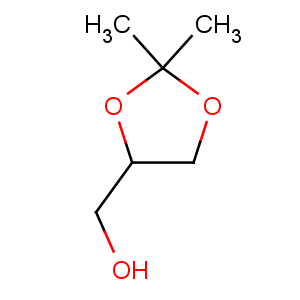Title: Isopropylidene Glycerol
CAS Registry Number: 100-79-8
CAS Name: 2,2-Dimethyl-1,3-dioxolane-4-methanol
Synonyms: 2,2-dimethyl-4-hydroxymethyl-1,3-dioxolane; glycerol dimethylketal; acetone glycerol
Trademarks: Solketal
Molecular Formula: C6H12O3
Molecular Weight: 132.16
Percent Composition: C 54.53%, H 9.15%, O 36.32%
Literature References: Prepn: Fisher,
Ber. 28, 1167 (1895); Fisher, Pf?hler,
Ber. 53, 1607 (1920); Hibbert, Morazain,
Can. J. Res. 2, 38 (1930); Smith, Lindberg,
Ber. 64, 510 (1931); M. M. Maglio, C. A. Burger,
J. Am. Chem. Soc. 68, 529 (1946); M. Renoll, M. S. Newman,
Org. Synth. coll. vol. III, 502 (1955); Mikschik,
AT 180926 (1955 to Chemomedica Chemikalien),
C.A. 49, 15951 (1955); Williams,
GB 802022 (1958 to Peter Spence & Sons);
GB 819835 (1959 to Bayer); Perez
et al., ES 499129 (1982 to Calipe),
C.A. 97, 55794v (1982). Synthesis of D(+)-form: E. Baer, H. Fischer,
J. Biol. Chem. 128, 463 (1939); of L(-)-form:
eidem, J. Am. Chem. Soc. 61, 761 (1939). Conversion of D(+)- to L(-)-form:
eidem, ibid. 67, 944 (1945).
Properties: Practically odorless liq of medium mobility. d420 1.064. bp10 82°.
nD20 1.4383. Viscosity (20°): 11 cP. Practically nonflammable at ordinary storage temps: Flash pt 90°C (194°F). Evaporation no. about 600 (ether = 1). Miscible with water, alcohols, acetals, esters, ethers, aromatic hydrocarbons, chlorinated hydrocarbons, gasolines, petr ether, turpentine, oils. LD50 in rats (g/kg): 7 orally; 3 i.p. (Perez).
Boiling point: bp10 82°
Flash point: Flash pt 90°C (194°F)
Index of refraction: nD20 1.4383
Density: d420 1.064
Toxicity data: LD50 in rats (g/kg): 7 orally; 3 i.p. (Perez)
Derivative Type: D(+)-Form
Properties: [a]D +13.6°; [a]D +10.8° (c = 15.19 in benzene).
Optical Rotation: [a]D +13.6°; [a]D +10.8° (c = 15.19 in benzene)
Derivative Type: L(-)-Form
Properties: [a]D -13.6°; [a]D -10.8° (c = 15.19 in benzene).
Optical Rotation: [a]D -13.6°; [a]D -10.8° (c = 15.19 in benzene)
Use: Versatile solvent and plasticizer. Pharmaceutic aid (solubilizing and suspending agent).

